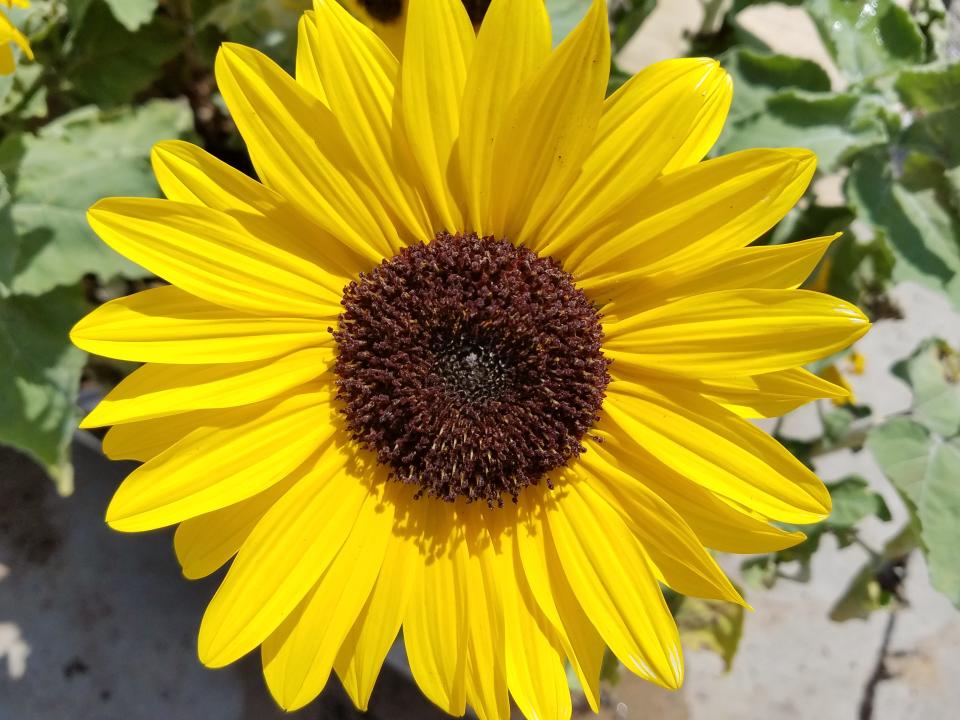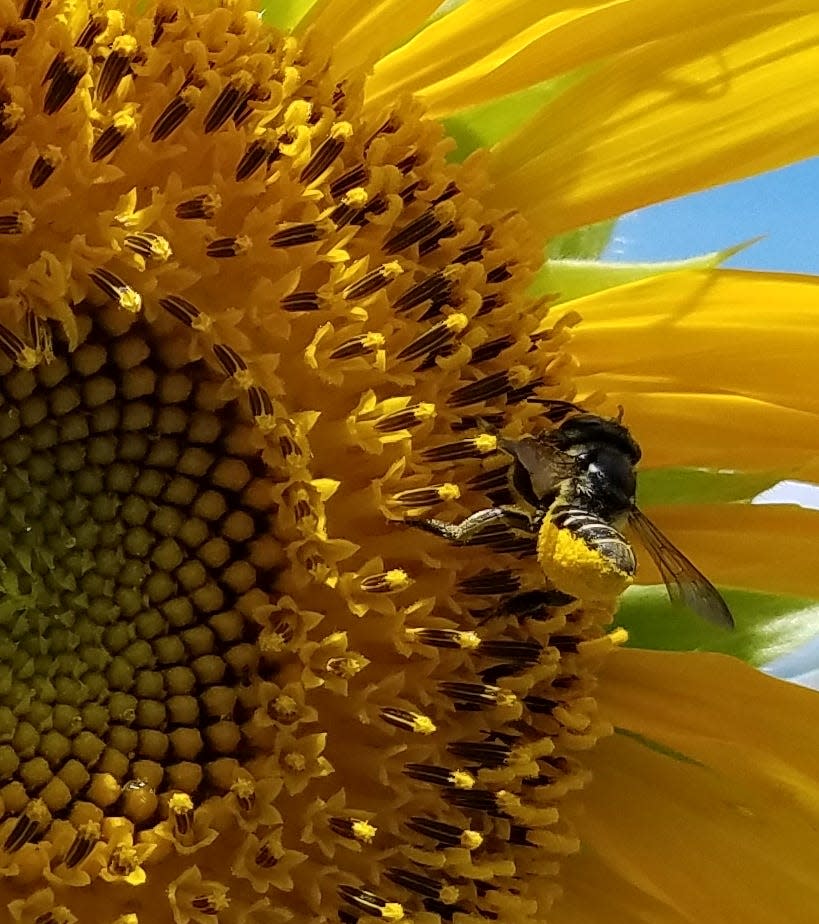Grow sunflowers: Birds, bees and butterflies will call your place home | Sally Scalera
I have an idea: Why not grow some annual sunflowers, Helianthus annuus, to feed the bees, butterflies, birds, and you? They are so easy to start from seed, so if you have never grown plants from seed before, give it a try and experience the fun and excitement of watching them grow. There is a huge selection of sunflower seeds to choose from, ones that provide food for wildlife, pollinators, and you!
An interesting characteristic of sunflowers is that the flowers have been known to follow the sun. I noticed that when I grew a patch of them years ago. Kids also have a lot of fun watching the plants grow and flower. Plant them in a sunny location where you can see them while inside your home.
Sunflowers are native to North America and were cultivated by native Americans thousands of years ago for oil, food, and decoration. In the 1500s, the Spanish conquerors took sunflowers back to Europe. The sunflowers spread to Russia where they did extensive work hybridizing them. In the 1800s, Russian immigrants brought the modern sunflowers back to North America. Florida is home to 15 native sunflower species, including three species found in Brevard County.

Sunflowers are a great food source for our native specialist bees, which need our help. Bees come in two types: specialists and generalists. The specialist bees have specific food requirements and rely on a single wildflower species or plant family for food. Generalist bees, in comparison, can get nectar and pollen from a wide variety of flowers. By taking care of the specialist bees, we will also be supporting the generalist bees.
When it comes to choosing which sunflower(s) to grow, you have multiple choices. Our garden centers have racks of seeds available now, and here are some of the sunflower seeds I found for sale: Mammoth, Autumn Beauty Mixed Colors, Busy Bee, Chianti Hybrid, Evening Sun Mixed Colors, Solar Eclipse, American Giant Hybrid, Dwarf Sunspot, Dwarf Teddy Bear, Evening Sun, Lemon Queen, Mammoth Russian, Red Sun, Velvet Queen, and Tiger’s Eye Mix.
A simple search on the internet will also provide you with even more sunflower seeds to choose from but be careful, or you could suffer from analysis to paralysis. When looking at all the choices from just one seed catalog, I noticed that all the cultivars for cut flowers also have low-pollen or, even worse, pollen-free flowers. The cultivars that produce sunflower seeds require bees for pollination, which leads to seed production.
More: Florida solitary bees keep flowers in bloom; here's how to attract them | Sally Scalera
If you aren’t a fan of eating sunflower seeds, then let the birds eat them. If you like to eat sunflower seeds, consider sharing some of the heads with the birds. In the past, I started many sunflower seeds by going to the health food store and purchasing raw sunflower seeds in the shell. The seeds sold for eating were large, with nice-sized seeds inside the shell. Those plants grew tall, from 8 to 10 feet tall. If height will be an issue, cultivars are available that produce seeds but only grow about half that tall. Consider growing sunflowers around, in, or near your vegetable garden also, so the bees will find your vegetable plants and pollinate them also.
Sunflower seeds can be planted directly in the garden or germinated in paper towels. Since vegetables and sunflowers need to grow in a sunny location, with at least six hours of direct sunlight each day, they make a good match. If you would prefer to sow your sunflower seeds directly in the garden, plant them one-half inch deep. The seeds will need to be kept moist to break dormancy. If you want to germinate them in paper towels, contact the UF/IFAS Extension Brevard County Master Gardeners at brevard-mg1@ifas.ufl.edu. It only takes about three weeks for the seedlings to produce their first set of true leaves, which is when they can be planted in the garden, yard, or in containers.
About half an hour before you plant the sunflower seedlings in the ground, water them thoroughly in the tray with a liquid organic fertilizer (i.e., Neptune’s Harvest Fish and Seaweed Fertilizer, etc.) so the root ball of each seedling is heavy and dripping wet when they are placed in the planting hole. While the seedlings are soaking up the solution in the tray, dig the holes and scatter some earthworm castings in each hole. When planting the seedlings, be sure not to plant them too deeply and press the soil around the root ball. After planting, water them and the surrounding soil. Another great product to scatter around the newly planted plants and surrounding area would be a volcanic powder (i.e., Azomite, etc.) to re-mineralize the soil.

Make sure to keep an eye on your newly planted sunflower plants and water them when their leaves begin to wilt. You can also establish the soil food web around the root system of your sunflower seedlings (and all the plants throughout your yard) by applying a liquid product that contains beneficial bacteria and mycorrhizae. Following the label directions, mix it in water, and water the plants with the solution. This could be repeated once again if you want. For more information about establishing the soil food web in your yard, ask the Master Gardeners about that also.
If you enjoy eating sunflower seeds, maybe you have some raw ones in your kitchen right now that you can germinate. Or maybe you would rather grow some seeds that are for sale at our local garden centers. Grow some in your yard or a container, and be sure to visit the flowers often, even at night with a flashlight, because you can watch all sorts of bees, butterflies, beetles, spiders, and other insects. Think of it as your very own entomology class!
Sally Scalera is an urban horticulture agent and master gardener coordinator for the University of Florida’s Institute of Food and Agriculture Sciences. Email her at sasc@ufl.edu.
This article originally appeared on Florida Today: Feed birds, bees, even yourself, with sunflowers | Sally Scalera

